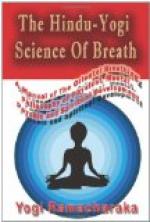(1) Stand or sit erect. Breathing through the nostrils, inhale steadily, first filling the lower part of the lungs, which is accomplished by bringing into play the diaphragm, which descending exerts a gentle pressure on the abdominal organs, pushing forward the front walls of the abdomen. Then fill the middle part of the lungs, pushing out the lower ribs, breast-bone and chest. Then fill the higher portion of the lungs, protruding the upper chest, thus lifting the chest, including the upper six or seven pairs of ribs. In the final movement, the lower part of the abdomen will be slightly drawn in, which movement gives the lungs a support and also helps to fill the highest part of the lungs.
At first reading it may appear that this breath consists of three distinct movements. This, however, is not the correct idea. The inhalation is continuous, the entire chest cavity from the lowered diaphragm to the highest point of the chest in the region of the collar-bone, being expanded with a uniform movement. Avoid a jerky series of inhalations, and strive to attain a steady continuous action. Practice will soon overcome the tendency to divide the inhalation into three movements, and will result in a uniform continuous breath. You will be able to complete the inhalation in a couple of seconds after a little practice.
(2) Retain the breath a few seconds.
(3) Exhale quite slowly, holding the chest in a firm position, and having the abdomen in a little and lifting it upward slowly as the air leaves the lungs. When the air is entirely exhaled, relax the chest and abdomen. A little practice will render this part of the exercise easy, and the movement once acquired will be afterwards performed almost automatically.
It will be seen that by this method of breathing all parts of the respiratory apparatus is brought into action, and all parts of the lungs, including the most remote air cells, are exercised. The chest cavity is expanded in all directions. You will also notice that the Complete Breath is really a combination of Low, Mid and High Breaths, succeeding each other rapidly in the order given, in such a manner as to form one uniform, continuous, complete breath.
You will find it quite a help to you if you will practice this breath before a large mirror, placing the hands lightly over the abdomen so that you may feel the movements. At the end of the inhalation, it is well to occasionally slightly elevate the shoulders, thus raising the collarbone and allowing the air to pass freely into the small upper lobe of the right lung, which place is sometimes the breeding place of tuberculosis.
At the beginning of practice, you may have more or less trouble in acquiring the Complete Breath, but a little practice will make perfect, and when you have once acquired it you will never willingly return to the old methods.




